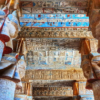Cairo City
It was established in 969 AD by Jawhar al-Siqilli, by order of the Caliph al-Muizz Ledin Allah. The Arabic name “Al-Qahira,” means “The Victorious.” because he wanted it to conquer the enemies and the jewel of the East. It was also called the city of a thousand minarets due to the abundance of mosques in it (the minaret is a symbol of the mosque for Muslims). The choice of the city’s location was not arbitrary but was in the middle of the country and next to the city of On (Heliopolis), which is considered the oldest ancient Egyptian city where ancient Egyptians thought and creativity appeared. Since its establishment until now, it has been the capital of the country and the seat of government. Historic Cairo includes the old neighborhoods such as al-Azhar and Muizz Street up to Bab Zaweela. Cairo now includes many important neighborhoods such as: Garden City and Zamalek on the Nile, then the famous Tahrir Square and what is known as downtown, then the Abbasia area, and Ain Shams, the area where there is an obelisk from about 2000 BC for King Senusret I of the Middle Kingdom, the 12th dynasty. There is also the famous landmark, the Tree of Mary, under which the saint Mary and Jesus took shelter when they fled to Egypt when Jesus was a child. Then we move to the modern establishments in Cairo such as New Cairo, Nasr City, and the settlements from the first to the tenth until we reach the new administrative capital, where most Egyptian ministries are now located. Its population is about 20 million, and it is connected to the city of Giza by some bridges, the most famous of which is Qasr al-Nil Bridge, which connects Khedivial Cairo (meaning the establishments that were established by Khedive Ismail in Cairo, including palaces and bridges, including Qasr al-Nil Palace, upon the opening of the Suez Canal in 1869). Also, there is the famous Cairo Tower, which was built in 1954. There are many tourist and archaeological landmarks, most importantly: • the Egyptian Museum in Tahrir, which was established in 1904. • The Citadel of Salah al-Din. • The area of Old Cairo includes the Religious Complex, consisting of 3 churches, a mosque, a Jewish temple, and a Roman fort. • Near this site, we find the Museum of Civilization, to which the royal mummies were transferred in 2022 from the Egyptian Museum in Tahrir. • Important mosques such as Sultan Hassan, Al-Rifai, Al-Azhar Mosque, the Ghuri complex, and Muizz Street. • Famous tourist area between Al-Azhar and Muizz, Khan el-Khalili. • There are mosques and shrines of the Ahl al-Bayt such as Al-Hussein, Sayyida Zeinab, and Sayyida Nafisa • Museums like: the Coptic Museum, the Islamic Museum, and the Royal Chariots Museum. • art museums such as the Mahmoud Khalil Museum. • The beautiful palaces that were used as headquarters for governance, such as Abdeen Palace and Kubba Palace. • historical palaces in New Cairo like: Baron Palace and the House of the Cretans (Gayer-Anderson Museum) • Palace of Prince Muhammad Ali in Manyal.
Cairo at night
Salah al-Din al-Ayyubi Citadel
Khan Al Khalili area

Tree of the Virgin Mary

The Egyptian Museum in Tahrir

Royal Chariots Museum

Obelisk of Senusret I

Downtown area
The Jewish temple from the inside

New Administrative Capital

Qasr El Nil Bridge
Baron Palace












